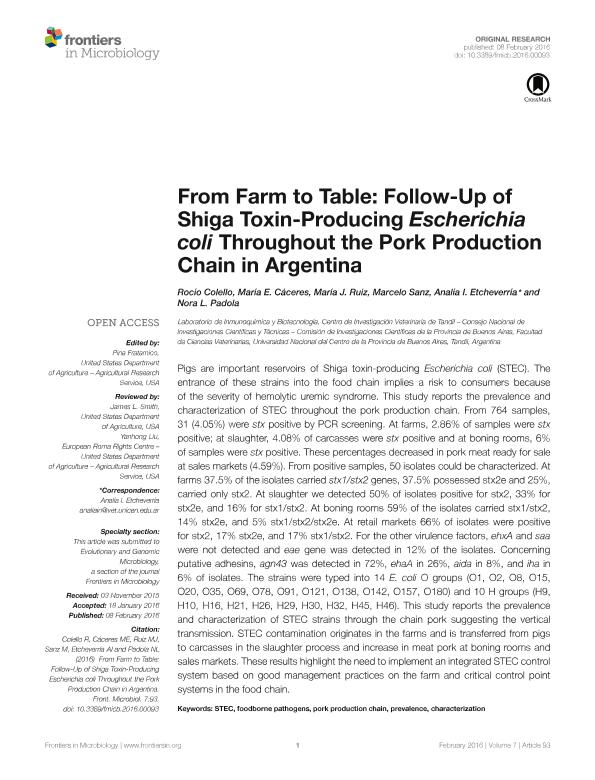Artículo
From farm to table: Follow-up of Shiga toxin-producing Escherichia coli throughout the pork production chain in Argentina
Colello, Rocío ; Cáceres, María Emilia
; Cáceres, María Emilia ; Ruiz, María Julia
; Ruiz, María Julia ; Sanz, Marcelo Eduardo; Etcheverría, Analía Inés
; Sanz, Marcelo Eduardo; Etcheverría, Analía Inés ; Padola, Nora Lía
; Padola, Nora Lía
 ; Cáceres, María Emilia
; Cáceres, María Emilia ; Ruiz, María Julia
; Ruiz, María Julia ; Sanz, Marcelo Eduardo; Etcheverría, Analía Inés
; Sanz, Marcelo Eduardo; Etcheverría, Analía Inés ; Padola, Nora Lía
; Padola, Nora Lía
Fecha de publicación:
02/2016
Editorial:
Frontiers Research Foundation
Revista:
Frontiers in Microbiology
ISSN:
1664-302X
Idioma:
Inglés
Tipo de recurso:
Artículo publicado
Clasificación temática:
Resumen
Pigs are important reservoirs of Shiga toxin-producing Escherichia coli (STEC). The entrance of these strains into the food chain implies a risk to consumers because of the severity of hemolytic uremic syndrome. This study reports the prevalence and characterization of STEC throughout the pork production chain. From 764 samples, 31 (4.05%) were stx positive by PCR screening. At farms, 2.86% of samples were stx positive; at slaughter, 4.08% of carcasses were stx positive and at boning rooms, 6% of samples were stx positive. These percentages decreased in pork meat ready for sale at sales markets (4.59%). From positive samples, 50 isolates could be characterized. At farms 37.5% of the isolates carried stx1/stx2 genes, 37.5% possessed stx2e and 25%, carried only stx2. At slaughter we detected 50% of isolates positive for stx2, 33% for stx2e, and 16% for stx1/stx2. At boning rooms 59% of the isolates carried stx1/stx2, 14% stx2e, and 5% stx1/stx2/stx2e. At retail markets 66% of isolates were positive for stx2, 17% stx2e, and 17% stx1/stx2. For the other virulence factors, ehxA and saa were not detected and eae gene was detected in 12% of the isolates. Concerning putative adhesins, agn43 was detected in 72%, ehaA in 26%, aida in 8%, and iha in 6% of isolates. The strains were typed into 14 E. coli O groups (O1, O2, O8, O15, O20, O35, O69, O78, O91, O121, O138, O142, O157, O180) and 10 H groups (H9, H10, H16, H21, H26, H29, H30, H32, H45, H46). This study reports the prevalence and characterization of STEC strains through the chain pork suggesting the vertical transmission. STEC contamination originates in the farms and is transferred from pigs to carcasses in the slaughter process and increase in meat pork at boning rooms and sales markets. These results highlight the need to implement an integrated STEC control system based on good management practices on the farm and critical control point systems in the food chain.
Palabras clave:
Characterization
,
Foodborne Pathogens
,
Pork Production Chain
,
Prevalence
,
Stec
Archivos asociados
Licencia
Identificadores
Colecciones
Articulos(CIVETAN)
Articulos de CENTRO DE INVESTIGACION VETERINARIA DE TANDIL
Articulos de CENTRO DE INVESTIGACION VETERINARIA DE TANDIL
Citación
Colello, Rocío; Cáceres, María Emilia; Ruiz, María Julia; Sanz, Marcelo Eduardo; Etcheverría, Analía Inés; et al.; From farm to table: Follow-up of Shiga toxin-producing Escherichia coli throughout the pork production chain in Argentina; Frontiers Research Foundation; Frontiers in Microbiology; 7; FEB; 2-2016; 1-7
Compartir
Altmétricas



